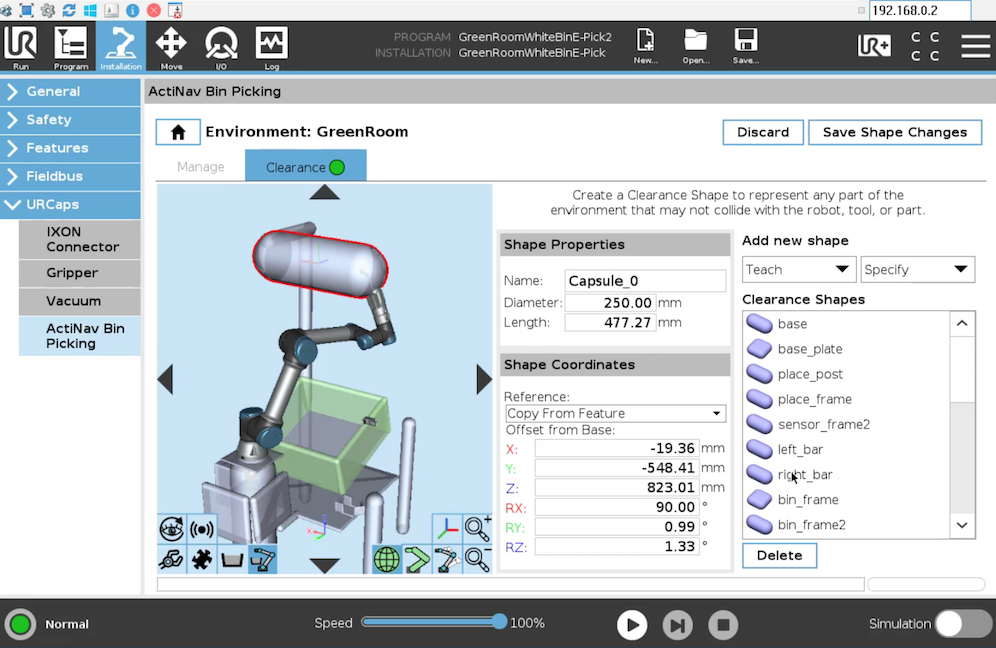
Although many robotics companies have claimed that they design for ease of use, accomplishing that has been a challenge. Easy deployment is crucial to getting companies to adopt automation and use it for new applications. With remote workers and increasing demand because of the COVID-19 pandemic, ease of use is more important than ever for robotics suppliers and end users.
Autonomous bin picking is a common robotics application, but it is rarely referred to as “easy to use.” Deploying autonomous bin-picking systems usually requires integration, and programming efforts customers can’t do themselves.
Universal Robots is hoping to change this with its new ActiNav autonomous bin-picking kit for machine-tending applications. ActiNav is the newest addition to the recently launched UR+ application kits, a series of “plug-and-produce” kits the company said will make it easier to deploy collaborative robots for common applications.
ActiNav requires a UR5e or UR10e cobot, an end effector of the user’s choice, and an application-specific frame or fixture. The kit includes the ActiNav software and autonomous motion module controller, the URCap user interface software, along with a choice of 3D sensors. It can handle vision processing, collision-free motion planning, and autonomous real-time robot control.
Jim Lawton, vice president of product and applications management at Universal Robots, said the UR5e and UR10e are the “sweet spots” for this application. “ActiNav works on the UR3e and UR16e as well, but large parts typically come in on a conveyor, and you can get away with a feeder and such on smaller parts,” he told Collaborative Robotics Trends.
ActiNav can autonomously insert parts into CNC or processing machines such as drilling, deburring, welding, trimming, or tapping.
ActiNav’s teach-by-demonstration programming
Odense, Denmark-based Universal Robots claimed that ActiNav requires no vision or robotic programming expertise to deploy. It uses a teach-by-demonstration approach via a wizard-guided setup process on the cobot’s teach pendant. The company said this can be done the first time in about two hours, and it generates just six to 12 lines of programming. The video above demonstrates the process, and here are the steps.

To train ActiNav on the bin, touch the top, bottom, and sides of the bin with the cobot’s end effector. To train the system on a pick, users need to attach the part at the pick point and scan it. To train a place in the environment, move the part to the location it is being placed. ActiNav will remember the part location and orientation. Then hit the play button on the teach pendant, and ActiNav should get to work.
“Anyone who’s used a UR robot before has figured out the teach pendant,” said Lawton. “The wizard is walking you through the steps in the interface you’re used to working with. You won’t need to hire an outside agency to set this up.”
ActiNav integrates Energid’s motion-control expertise
ActiNav actively navigates the robot autonomously into the bin, moving through the environment without collisions and placing parts into a machine. To do this, Universal Robots tapped into the expertise of its sister company, Energid Technologies, which makes the Actin real-time adaptive motion control software. Bedford, Mass.-based Energid’s areas of expertise include bin picking, which it demonstrated trade shows during the launch of Actin 5 in 2018. Check out this demo from IMTS 2018, for example:
Bin-picking demo from @Energid using @Universal_Robot. Actin software running in background figuring out how to best get robot from Point A to Point B #robotics #robots #IMTS2018 pic.twitter.com/GUt0XjnBbX
— The Robot Report (@therobotreport) September 11, 2018
Teradyne Inc., a Reading, Mass.-based developer of automatic test equipment, owns both Energid and Universal Robots. It acquired Energid in 2018 for an undisclosed amount, while Teradyne bought Universal Robots in 2015 for $285 million. If you’ve ever wondered about the synergy between the three companies, wonder no more.
Machine tending a cobot opportunity
Lawton said machine tending as a category offers more than 20 million opportunities for cobot companies. But tending in a lot of environments, especially if you’re picking from a deep bin, can be tough to do.
“Machine tending has always been one of the mainstay applications for our collaborative robot arms,” he said. “We discovered a significant market need for a simple solution that enables UR cobots to autonomously locate and pick parts out of deep bins and place them precisely into a machine. This is not pick and drop; this is accurate pick and part-oriented placement.”
According to Universal Robots, ActiNav costs about $100,000, but the ability for quick deployment provides a return on investment in less than 18 months of a two-shift operation. The company also claimed that ActiNav reduces deployment time by three to six weeks when compared to other autonomous bin-picking systems.

ActiNav expands UR+ application kits
Universal Robots has been testing ActiNav with early access customers since mid-2019, said Lawton. He added that ActiNav mirrors the mantra of the other UR+ application kits: Make it easier for customers to deploy automation and lower their risk.
“We looked at customer’s recent applications with cobots and the amount of time involved with each step of deployment,” he said. “There was good news and bad news. The good news is the programming has become so easy it represents about 10% of the time to deploy a cobot. The bad news is the other 90% percent of the time is spent on choosing the end effectors and sensors and figuring out if the system actually works.”
“Launching these kits takes all of that out of it. We’ve done all the work,” said Lawton. “You’re buying this kit with all these parts that work together reliably. Just work your way through ActiNav’s setup wizard, and hit Play.”


Leave a Reply
You must be logged in to post a comment.